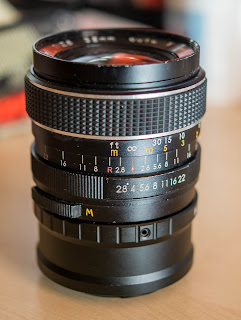The Helios-44 was the standard, fast, 58mm lens typically found as the kit prime on the Zenit-series russian SLR cameras, produced from 1958 till 1992. There are numerous variants available, some of which include multicoated lens elements. And they were made in more than one factory. KMZ (Krasnogorski mechanitscheski sawod) was probably the most prolific producer.
Based on the lens Zeiss Biotar 2/58 , at the beginning was called "БТК" - "БиоТар Красногорский" (BioTar Krasnogorski). A fast 6-element anastigmat, it was available in both single-coated and multi-coated versions.
The name of Helios lenses are usually written as Helios-44X-N, where X -is the index of lens mount (M for m42 thread, K for Pentax K bayonet, Д for Zenit-D bayonet) and N is a optical resolution index 2, 3, 4, 5, 6, 7 (the higher number the higher is an optical resolution of lens). The Russian designers of the Helios-44 lenses were P.A.Lapin and W.N. Borodulin from the KMZ plant in Krasnogorsk.
A bit chunkier and heavier than the other versions, the 44-M has the advantage of a wide base that mounts firmly with a rimless M42 adapter on Pentax. It has an A-M aperture switch, not the 2 ring preset aperture of the common 44-2.
There are obviously in the net infinitely many different copies. Here are the data that apply only to my copy with M42-Mount:
52mm filter thread (In the net usually specified with 49mm)
8 diaphragm blades (I have counted myself ;o))
F/2-16 max-min aperture.
50cm minimum focusing distance.
A mag ratio of 1:6.5 at closest focus point.
Weight: 230 gr.
 |
| From Camerapedia, uploaded from User Plt712h (2011) |
Usually you pays for good specimens between 20 to 40 Euro. I have it mounted with a very cheap M42 adapter from Shanghai to my Sony a6000. Such Chinese adapters can be bought via Amazon or EBay. They cost about 10, - Euro and are of good quality. I bought several such adapters (PK-, FD-, M39-, LeicaM-, Nikon Ai- or other mounted) from China and never had any real scrap. I can really recommend these pieces from Far East.
Let's look at the picture quality: When the aperture is open, so f / 2.0 the images are very sharp in the center of the image. To the edges everything becomes very soft and blurred.
 |
| Sony a6000 with Helios-44M at f/2.0, 1/1000s, ISO 100, look at the light swirly bokeh in the right background. |
 |
| Sony a6000 with Helios-44M at f/2.8, 1/250s, ISO 100 against the light of sunset (the flares are inconspicuous) |
 |
| Sony a6000 with Helios-44M at f/2.8, 1/80s, ISO 100 at closest focusing distance |
The lens is, moreover, wide open very light-sensitive, the photos are then low-contrast and fuzzy. The use of a lens hood is recommended. For my review, I unfortunately had no matching lens hood at home, but 52mm should not be a problem. This is a common size and not expensive.
Easily stopped down, the picture quality is excellent. Even at aperture 2.8 the photo looks almost like Zeiss-like. At aperture 5.6 the image from edge to edge are really correctly perfect.
Here is a photo at aperture f/2.8 and below as a 100% -crop.
The bokeh is most comparatively creamy and quiet. In the net you can read a lot of the swirly bokeh of the Helios 44M. This is, however, the version Helios 44M-4 or 44M-2. My copy, so the Helios M44 without lens-index and 8 blades is a later version from the 70s. The production of the Helios-44M ended in 1972. General rule is: the older the Helios and more blades, the most swirly character. On the other hand, a restless background at the right distance can also produce this swirly bokeh. You have to experiment a bit. Look at my first Danbo-picture in this post.
Let's summarize: The lens is cheap to have, as Russian bulk goods you get it on many platforms in the net. The picture quality is good from f/2.8, really perfect from f/5.6. The blinds snapped in well and audibly. The haptics are very solid like a Russian tank. From my own experience, I can finally recommend this lens. It is not my favorite and best Fifty, but a good performer for daily use.
When I shoot with this lens on an APS-C camera, the focal length extends to about 87mm. This is already a light telephoto focal range at the full format. In the everyday life of photography, therefore, rather a portrait focal length. My pictures in the following part of the report show, however, that the lens can actually be used for any purpose.
 |
| Sony a6000 with Helios-44M at f/2.8, 1/40s, ISO 100 |
 |
| Sony a6000 with Helios-44M at f/5.6, 1/500s, ISO 100 |
 |
| Sony a6000 with Helios-44M at f/5.6, 1/640s, ISO 100 |
 |
| Sony a6000 with Helios-44M at f/2.0, 1/125s, ISO 100 (processed with Nik Silverefex) |
 |
| Sony a6000 with Helios-44M at f/2.0, 1/30s, ISO 640 |
 |
| Sony a6000 with Helios-44M at f/2.8, 1/100s, ISO 100 |
 |
| Sony a6000 with Helios-44M at f/4.0, 1/250s, ISO 100 |
 |
| Sony a6000 with Helios-44M at f/2.8, 1/125s, ISO 100, 50%-crop from original picture |
 |
| Sony a6000 with Helios-44M at f/2.8, 1/60s, ISO 125 |
 |
| Sony a6000 with Helios-44M at f/2.8, 1/640s, ISO 100 |
 |
| Sony a6000 with Helios-44M at f/2.8, 1/160s, ISO 160 |




















































